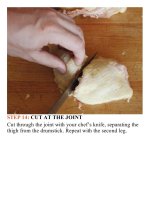The food lab better home cooking through science ( PDFDrive ) 705
Bạn đang xem bản rút gọn của tài liệu. Xem và tải ngay bản đầy đủ của tài liệu tại đây (190.59 KB, 2 trang )
AsplumpandjuicyasabenevolentauntinaDisneyfilm.
Tasting it, there’s a definite case of wet-sponge syndrome.
Water comes out of it as you chew, giving you the illusion
ofjuiciness,butthetextureisalittletoolooseandtheflavor
alittlebland.
Moving on to the salted breast, we find that it’s still
significantlymoisterthanthenonsaltedbreast(thoughitwas
a couple of percentage points drier than the brined breast).
Tasting it, it’s undoubtedly more juicy and well seasoned,
withastrongerchickenflavor.Texturewise,it’ssignificantly
different from both plain and brined turkey, with the
smooth,dense-but-tendertextureoflightlycuredmeat.
Visually, you can see clear signs of this curing with its
decidedlypinkhue:
Dry-brinedchickenbreast.
With a small chicken breast, the moist pink cured section
extends nearly to the center of the breast. On a turkey,
you’d only see it around the outer edges (which,
serendipitously, happen to be the parts most prone to
overcooking and drying out). While the brined breast was
slightly juicier, flavorwise and texturewise, I’d take the
saltedchickenoverthebrinedanyday.
WhatAboutFlavoredBrines?
First off, don’t try to brine your turkey or chicken in cider
(or any other acidic marinade, for that matter). Just don’t.
Theacidintheciderwillbeginthedenaturizationprocessof
themeat,effectively“cooking”itwithoutheat.Theresults?
Ultradry meat with a wrinkled, completely desiccated
exterior,likethis:
Cider-brinedchickenbreast.
More interesting were the results of the broth brined
chicken.Itseemsliketheultimatesolution,right?Ifbrining
forces bland water into your meat, why not replace that
waterwithflavorfulbroth?
Unfortunately,physicsisaficklemistresswhorefusesto
bereinedin.Intastingthebroth-brinedchickennexttothe
plain brined chicken, there was barely a noticeable









